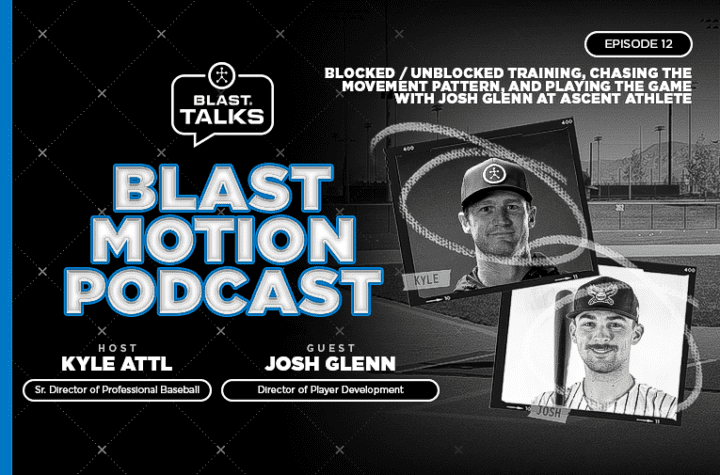
Unlike club fitting in golf, bat fitting in baseball and softball is not widely practiced. However, with swing data becoming more accessible through bat sensors like Blast Baseball and Blast Softball, bat fitting is gaining traction.
The Bat Fitting Process
Mark Spencer, president of Sports 4N6 (a funny take on “forensics”), started this data-driven athletics performance company last fall. As a new company, Spencer decided to initially focus on baseball and softball using a service called the “Data Cage” for pitchers and hitters.
Spencer uses the Blast Baseball sensor and app with FlightScope Strike.
He discusses the bat fitting process:
What he looks for overall:
• Bat Speed
• Bat Path (using 3D Swing Tracer)
• Swing Plane
• Time to Contact
• Exit Velocity
• Launch Angle
• Carry Distance (or Hit Distance)
Step One
“I think fitting is a collaborative effort between the fitter and the player,” he says. Before anyone takes a swing, he talks to the player. “If it’s a nine-year-old kid, I will talk to both the player and the parent, but I’ll slowly move the conversation to where the player is answering.”
He says that with the younger players, it is harder for them to open up. So, the first thing he asks is, “What are your goals?”
Spencer makes sure that the player understands a player can’t give incorrect answers to the questions he asks. “As objective as the data is, data doesn’t care about your feelings; data doesn’t care if you’re having a good day or a bad day. It’s going to display what happened on that last hit. It knows no bias,” he says.
Step Two
Spencer then looks at the player’s swing. He’ll look at five to seven metrics, such as Time to Contact, Bat Speed, and swing plane, as well as the player’s biggest deficiency. “If our plane is good, but our launch angles and exit velocities aren’t where they need to be, I know something is off.”
He points out that sometimes there is a mechanical deficiency where the player isn’t sequencing or organizing movements properly, “But there are things you can do in a bat to correct that.”
“A lot of things that happen in a swing are a reaction, not only to the pitch, but also to what the player is holding in their hands.” he says. Before making adjustments to the swing, Spencer likes to start with fixing the static piece, or the bat, because “static doesn’t take ability.”
Step Three
He begins to correct the swing. Looking at deficiencies and the type of bat used, he asks:
• What’s the length?
• What’s the weight?
• Does that bat’s makeup cause some of these deficiencies in the movements?
“Organizing movement is important for a player and I want to make sure that the tool in their hands isn’t causing deficiencies.”
Step Four
“You can’t let past fittings make you biased. What I do on all fittings is I swing the pendulum very far in one direction,” says Spencer.
“Then I work my way back and the whole time, I’m asking questions and watching the data. I’m watching how they react. If they’re getting a perfect meatball right down the middle, what happens when I throw it inside and it’s up a little bit? Is he able to turn on it and really pull it and with the proper launch angle? What happens if I throw the ball low and outside accidentally, or purposely really, and he’s able to still launch it in the air, but it goes the opposite direction with good exit velocity?”
Spencer knows when he’s onto something when the player is able to start making dynamic adjustments and react to different pitch locations correctly.
Step Five
Start the hunt.
After evaluating the player and discovering length and weight boundaries, Spencer starts to narrow his search down to the exact bat. “The brand, to me, is really not as important as the makeup,” he says.
He uses the Blast Baseball app at this point to show him how players react to lighter feeling or heavy bats. “When I see a number jump, I will stop and ask him, “Hey, tell me what you’re feeling. What feels different about this bat?” And in most cases, they explain it and Spencer can match it up to what he’s seeing in the numbers.
Case in point: a 12-year-old player came in and Spencer watched him swing with especially fast Bat Speed for his age, but his Attack Angle was consistently negative, around -9 degrees. “The pitch comes across the plate at almost -10 degrees at that level. If it’s something a little off-speed, it’s going to be up to 20 degrees downward. And if you’re trying to hit a ball with your bat going down nine degrees with the ball coming the other direction going down 20, you have about a 2-inch window to be perfect, to make it a functional hit,” he says.
Spencer fit him with the proper bat and his Attack Angle went from -9 to positive 6, his Bat Speed slowed down 1.5 miles per hour, and exit velocity increased more than 10 miles per hour. He notes that Bat Speed and exit velocity are not the end all be all metrics. It’s more about the quality of contact, and sometimes hitters will lose a little speed to make better contact and square up more balls.
Find more from Mark Spencer of Sports 4N6 and The Data Cage below.
Twitter: @TheDataCage
Facebook: Sports 4N6
Instagram: @thedatacage













